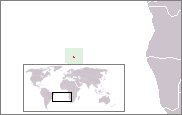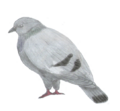Saint Helena dove facts for kids
Quick facts for kids Saint Helena dove |
|
|---|---|
 |
|
| Hypothetical restoration | |
| Conservation status | |
| Scientific classification | |
| Genus: |
Dysmoropelia
|
| Species: |
dekarchiskos
|
 |
|
| Location of Saint Helena | |
The Saint Helena dove (Dysmoropelia dekarchiskos) was a type of flightless bird. It belonged to the Columbidae family, which includes doves and pigeons. This unique bird was the only species in its group, called Dysmoropelia.
It lived only on the island of Saint Helena. This island is located in the South Atlantic Ocean. Scientists found its bones from the Late Pleistocene period. This time was long ago, during the last Ice Age. The bones were found at a place called Sugarloaf Hill. This area has sandy soil made of calcium carbonate.
Contents
What We Know About the Saint Helena Dove
Scientists found many bones of the Saint Helena dove. These bones helped them learn about the bird. The main bone found was a right coracoid. This is a bone in the shoulder area. Other bones found included parts of legs, wings, and hips. These discoveries helped scientists understand how the bird looked and lived.
How It Looked
The Saint Helena dove was a fairly large bird. It had short wings compared to its body size. Its legs were strong and thick. This bird had some of the most extreme features for a flightless dove. It was similar to other famous flightless birds. These include the Dodo and the Rodrigues solitaire. It also resembled the Viti Levu giant pigeon.
When Did It Disappear?
People believe the Saint Helena dove became extinct a long time ago. One idea is that it disappeared soon after the island was found in 1502. This might have happened because of hunting. However, there are no written stories about the bird from that time.
Another idea suggests it died out even earlier. Some scientists think it disappeared before or during the Last Glacial Maximum. This was the coldest part of the last Ice Age. This means it might have been gone before humans arrived.
Its Relatives
Scientists have studied the bones of the Saint Helena dove. They think it might be related to Streptopelia turtle doves. This idea comes from looking at the shape of its bones.
Images for kids
-
Location of Saint Helena
See also
 In Spanish: Paloma de Santa Helena para niños
In Spanish: Paloma de Santa Helena para niños




